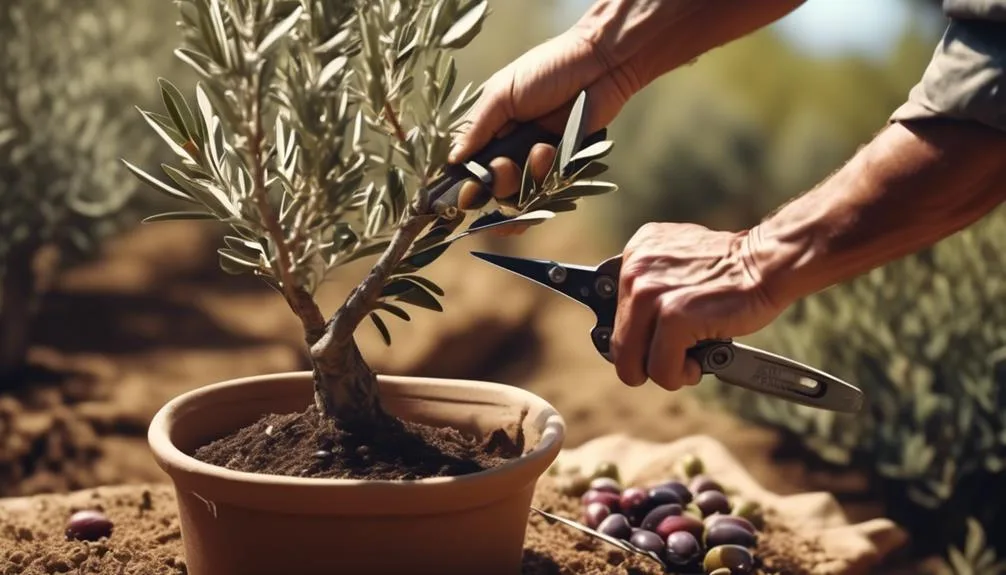Curious about growing olive trees from cuttings? It's easier than you think! With the right knowledge and techniques, you can successfully propagate olive trees and expand your collection.
Let's explore the process of growing new olive tree specimens from cuttings.
Key Takeaways
- Select healthy, young olive tree cuttings with at least three sets of leaves
- Utilize pruning techniques to take cuttings from the previous year's growth
- Remove leaves from the lower two-thirds of the cutting to promote root development
- Use a well-draining mix of soil and sand as a growing medium
Selecting the Right Olive Tree Cuttings
To ensure successful propagation, choose healthy, young olive tree cuttings with at least three sets of leaves for optimal growth. When selecting cuttings, look for those that are about 6-8 inches long and are free from diseases or pests.
Utilize pruning techniques to take cuttings from the previous year's growth, ensuring a clean cut just below a leaf node. This encourages the growth of new shoots from the node.
Additionally, consider using growth hormones to stimulate root development, especially if the cuttings are from mature trees. These hormones can help expedite the rooting process and improve the overall success rate of propagation.
Preparing and Treating Olive Tree Cuttings
When preparing and treating olive tree cuttings, carefully remove any leaves from the lower two-thirds of the cutting to promote successful root development. This step is crucial as it encourages the cutting to focus its energy on root formation rather than sustaining foliage.
Additionally, consider using rooting hormones to expedite the rooting process. These hormones stimulate root growth and can increase the chances of successful propagation.
After treating the cuttings, you can opt for water propagation by placing the prepared cuttings in a container of water. Change the water regularly to prevent molding and ensure the cuttings are exposed to indirect sunlight. This method allows you to monitor root development and is an effective way to propagate olive trees from cuttings.
Planting Olive Tree Cuttings
Now that the olive tree cuttings have been prepared and treated, it's time to move on to the next step of planting them for successful propagation. When planting olive tree cuttings, there are a few key factors to consider for optimal growth:
- Choose a Suitable Growing Medium: Use a well-draining mix of soil and sand to plant the cuttings, ensuring good aeration and moisture retention.
- Rooting Hormone Application: Dip the base of the cutting in rooting hormone before planting to encourage root development and increase the chances of successful propagation.
- Watering Frequency: Keep the soil consistently moist but not waterlogged. Water the cuttings regularly, ensuring the growing medium doesn't dry out completely.
Caring for Newly Propagated Olive Trees
After successfully propagating your olive tree cuttings, it's essential to provide proper care to ensure their healthy establishment and growth. Here are some essential aspects to consider for caring for newly propagated olive trees:
| Care Aspect | Description |
|---|---|
| Watering Frequency | Water the newly propagated olive trees regularly, keeping the soil consistently moist but not waterlogged. Olive trees prefer well-draining soil to prevent root rot. |
| Soil Type | Use well-draining soil with a mix of sand, perlite, and organic matter to ensure proper root development and prevent waterlogging. |
| Sunlight Exposure | Place the olive trees in a sunny location, ensuring they receive at least 6-8 hours of sunlight per day for optimal growth. |
| Pruning Techniques | Prune any dead or damaged branches and shape the tree to encourage a strong and balanced structure as it grows. Avoid heavy pruning during the initial growth phase. |
Troubleshooting Common Issues in Olive Tree Propagation
As you care for your newly propagated olive trees, it's important to be prepared to troubleshoot common issues that may arise during the propagation process. Here are some key points to help you identify and manage potential problems:
- Identifying Fungal Infections: Keep an eye out for signs of fungal infections such as wilting, yellowing or browning of leaves, or the presence of mold on the soil surface. If you notice any of these symptoms, promptly remove the affected plant and adjust your watering practices to prevent further spread.
- Managing Temperature Fluctuations: Fluctuations in temperature can stress young olive trees and make them more susceptible to disease. Ensure that your propagation area maintains a consistent, moderate temperature to promote healthy growth and minimize the risk of temperature-related issues.
- Regular Monitoring: Regularly inspect your propagated olive trees for any signs of distress or disease. Catching issues early can significantly improve the chances of successful propagation.
Conclusion
Incorporate these propagation techniques into your gardening routine to cultivate your very own olive tree garden.
With the right cuttings, proper preparation, and attentive care, you can successfully propagate olive trees.
If you encounter any challenges, refer back to this guide for troubleshooting tips.
Happy propagating, and may your olive tree garden flourish!

